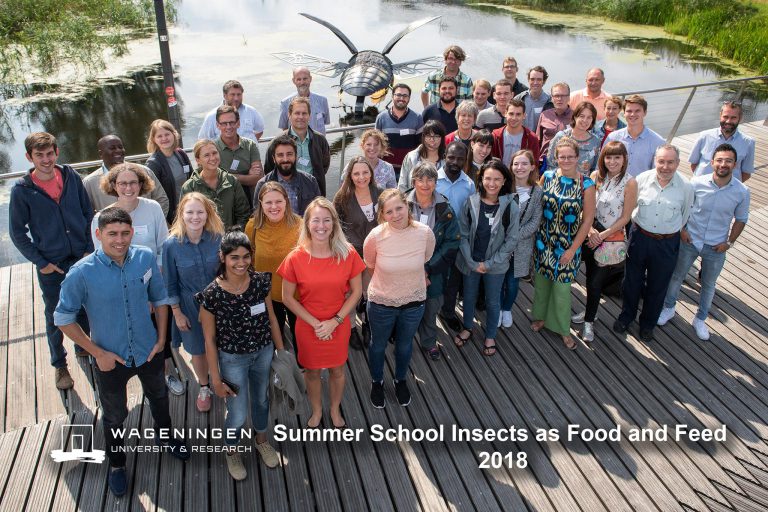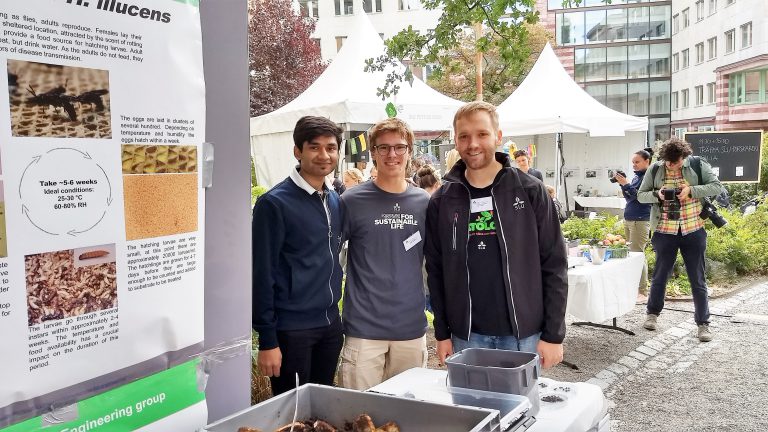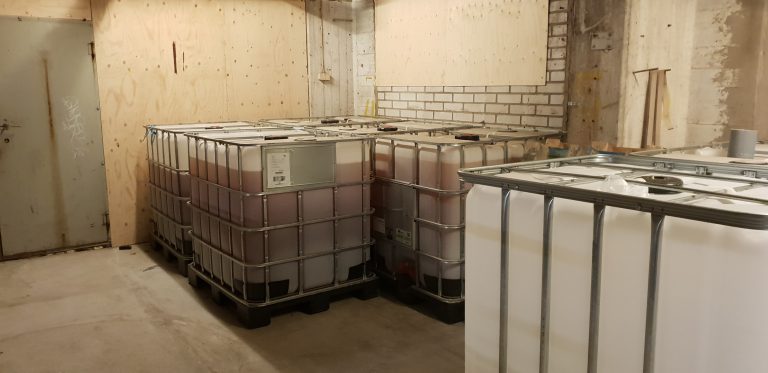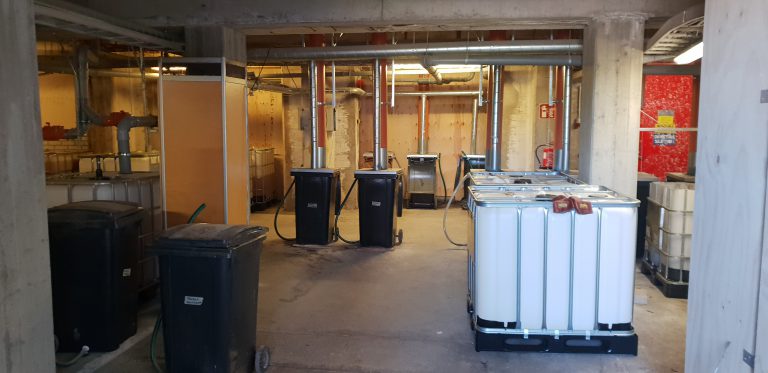Last week, Viktoria Wiklicky from our research group participated in the Summer School “Insects as Food and Feed – from producing to consuming” organised by Wageningen University. The summer school looked at various aspects of the insect food and feed chain, from from genetics to farming, handling/logistics, processing, marketing and consumption. The course was very well received by its participants, many of whom almost bombarded the lecturers with a range of interesting questions! One highlight was the study visit to Belgium where participants spent a whole day at the Thomas More University of Applied Sciences and the University of Leuven, receiving lectures and a tour through the research facilities, with focus on their ongoing insect projects. 
Sommarskola, insekter som mat och foder
Förra veckan deltog Viktoria Wiklicky från vår forskargrupp i sommarskolan ”Insekter som mat och foder – från produktion till konsumtion” som organiserats av Wageningen University. Sommarskolan tittade på olika aspekter av insektsmat- och foderkedjan, från genetik till jordbruk, hantering/logistik, bearbetning, marknadsföring och konsumtion. Kursen mottogs mycket väl av deltagarna, av vilka många nästan bombarderade lärarna med en rad intressanta frågor! En höjdpunkt var studiebesöket i Belgien där deltagarna tillbringade en hel dag vid Thomas More University of Applied Sciences och University of Leuven och fick föreläsningar och en rundtur genom forskningsanläggningarna, med fokus på sina pågående insektsprojekt.

Fluglarvskompostering presenterades vid Matologi

Vår fluglarvsgrupp deltog i evenemanget Matologi som årligen arrangeras av SLU. Fokus för årets utställning var svinn och klimat. Evgheni Ermolaev, Giulio Zorzetto och Panav Gupta presenterade konceptet Kretsloppsfluga, en fluglarvsbaserad behandling av organiskt avfall som utvecklats av gruppen. Vidare visades behandlingsmodulen som är skalbar att behandla ett ton om dagen och som nu testas vid en pilotanläggning i Eskilstuna Strängnäs Energi och Miljö AB.
Fly larvae composting presented at Matologi
 Our fly larvae team participated in the yearly Matologi event organized by SLU. This year’s exhibition had a focus on waste and climate. Evgheni Ermolaev, Giulio Zorzetto and Panav Gupta presented the Kretsloppsfluga concept being developed by the group and showed the treatment module currently being tested at a pilot plant at Eskilstuna Strängnäs Energi och Miljö AB.
Our fly larvae team participated in the yearly Matologi event organized by SLU. This year’s exhibition had a focus on waste and climate. Evgheni Ermolaev, Giulio Zorzetto and Panav Gupta presented the Kretsloppsfluga concept being developed by the group and showed the treatment module currently being tested at a pilot plant at Eskilstuna Strängnäs Energi och Miljö AB.
Den sjätte torrtoalettkonferensen, Finland
Prithvi Simha, doktorand i kretsloppsteknik, deltog i den sjätte internationella torrtoalettkonferensen som hölls i Tammerfors, Finland, mellan 22-24 augusti. Prithvi presenterade vår pågående forskning om alkalisk urinuttorkningsteknik och delade erfarenheter av att installera och driva en hushållsskalig urinsorteringsenhet under tre månader på SLU-campus.

Konferensen anordnades av Finlands globala toalettförening som är värd för evenemanget vart tredje år. I år var arenan Hiedanranta, ett tidigare industriområde i Tammerfors, Finland där alla toaletter är vattenlösa (såklart!). Urin och avföring samlas under platsen i en källare – konferensarrangörerna uppskattade att nästan 500 liter urin samlades in under det tre dagar långa evenemanget.
Länkar: Dry Toilet 2018 – Book of Abstracts Global Dry Toilet Association of Finland Visit Hiedanranta
Kontakt: Prithvi Simha
The 6th Dry Toilet Conference, Finland
Prithvi Simha, PhD student at kretsloppsteknik, participated in the 6th International Dry Toilet Conference that was held in Tampere, Finland, between 22-24 August. Prithvi presented our ongoing research on alkaline urine dehydration technology and shared experiences of installing & operating a household-scale urine dehydration unit for three months at the SLU campus. 
Antibiotikaresistens-seminarie under Världsvattenveckan

SLU arrangerade tillsammans med SIWI, SIANI and Nordea ett antibiotikaresistens-seminarie under Världsvattenveckan. Annika Nordin var vår representant och talade om vikten av WASH (Water, Sanitation and Hygiene) för att begränsa spridning av antibiotikaresistens. Workshopen kring WASH och antibiotikaresistens lockade ca 20 personer. Den övergripande slutsatsen var att källsorterande sanitet kan vara ett sätt att effektivare kontrollera spridningen från avlopp. Detta eftersom både antibiotikan och patogenerna kommer att vara koncentrerade i en mindre fraktion som kan hanteras enklare jämfört med stora volymer blandat avloppsvatten. Kontroll av antibiotikaresistens kräver att fler aspekter än patogenavdödning beaktas vid behandling, dock kan hygienisering resultera i betydande förbättring av spridningen av antibiotikaresistens från avlopp jämför med nuvarande hantering.
Antimicrobial resistance (AMR) seminar at the World Water Week

SLU co-organised an antimicrobial resistance (AMR) seminar at the World Water Week together with SIWI, SIANI and Nordea. Annika Nordin was our representative talking about the importance of WASH to limit the spread of AMR. The sub-workshop regarding WASH and AMR was popular, with 20 people attending. The general conclusion was that source separating sanitation may be a way to better control the spread as we contain most of the antibiotics and the pathogens in a concentrated fraction that could be managed in a simpler way compared to if it is diluted with water. Managing the AMR may require that more treatment aspects than pathogen control is considered. However, inactivating the pathogens may result in considerably improved situation compared to current situation.
Ny praktikant som arbetar med flyglarvskompostering
Möt Panav Gupta – gruppens senaste praktikant från Indien som för närvarande arbetar med teamet för fluglarvskompostering. Under sitt kandidatprogram i civilteknik var Panav mycket intresserad av avfallshanteringen, särskilt de potentiella och ekonomiska utsikterna för att använda amerikanska vapenflugslarver (BSFL) för att behandla olika typer av avfall. Han besöker vår grupp på SLU för en två månaders praktik som började i juli. Under denna tid kommer han att lära sig om uppfödning och användning av BSFL för behandling av musslor och grisfoder samt att förstå utsikterna för att använda BSFL för behandling av lignocellulosisk biomassa som risstrå – en möjlig lösning för problemet med stubbförbränning i Nordindien.

New intern working on fly larvae composting
Meet Panav Gupta – the group’s latest intern from India who is currently working with the black solider fly team. During his bachelors program in civil engineering, Panav was very interested in the field of waste management, especially the potential and economic outlook of using Black Soldier Fly Larvae (BSFL) for treating various types of waste. He is visiting our group at SLU for a two month long internship that began this July. During this time, he will learn about rearing and using BSFL for treating mussels and pig feed as well as understand the prospects of using BSFL for treating lignocellulosic biomass like rice straw – a possible solution for the problem of stubble burning in North India. PC: Giulio Zorzetto
PC: Giulio Zorzetto


